Submitted by South Sound GREEN
In the face of COVID-19 and recent stay at home order, parents and guardians may find themselves looking for activities that not only keep students engaged, but also provide information about local environmental science and concerns. In our South Sound GREEN Home Based Science Project series, we will introduce and demonstrate various hands-on and at-home activities for children of all ages to do either indoors or outside!
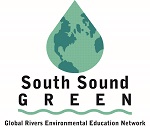 This time we continue learning about water quality by talking about the importance of nitrates!
This time we continue learning about water quality by talking about the importance of nitrates!
Title: Nitrate Bingo
Grade Level: 5th-9th
Materials:
- Bingo card (provided below)
- Pen/pencil
- Clipboard
Background
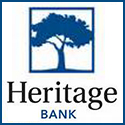 In earlier activities, we talked about a few other water quality parameters that students involved in the South Sound GREEN Water Quality Monitoring program test for. This included Soda Science, where we talked about dissolved oxygen, and Turbidity Trials, where we talked about turbidity (find those activities and more here!). Here, we’re going to talk about another water quality parameter, and one that is just as important as the others for salmon – nitrates!
In earlier activities, we talked about a few other water quality parameters that students involved in the South Sound GREEN Water Quality Monitoring program test for. This included Soda Science, where we talked about dissolved oxygen, and Turbidity Trials, where we talked about turbidity (find those activities and more here!). Here, we’re going to talk about another water quality parameter, and one that is just as important as the others for salmon – nitrates!
Nitrogen is an essential element for all living organisms. Nitrates is the form of nitrogen that is used by plants and animals. When nitrogen is readily available in a form plants can use, such as nitrate, plant growth can explode. Nitrates generally come from organic, or natural, sources such as decomposing plant and animal material. Nitrates are also found in chemical fertilizers, animal waste (including human sewage), and stormwater runoff.
If you have ever worked in a home garden or farm, you might know that growing plants is sometimes harder than it looks! As primary producers, plants create their own food from the sun, but they still need some nutrients like nitrates from the soil to help them grow. Nitrates are used up by plants, which means gardeners and farmers often need to add the right amount of nitrates back to the soil in the form of compost or fertilizer. If too much fertilizer is added, the excess nitrates can run off into local streams and waterways, causing algae to “bloom”, or grow quickly and abundantly.
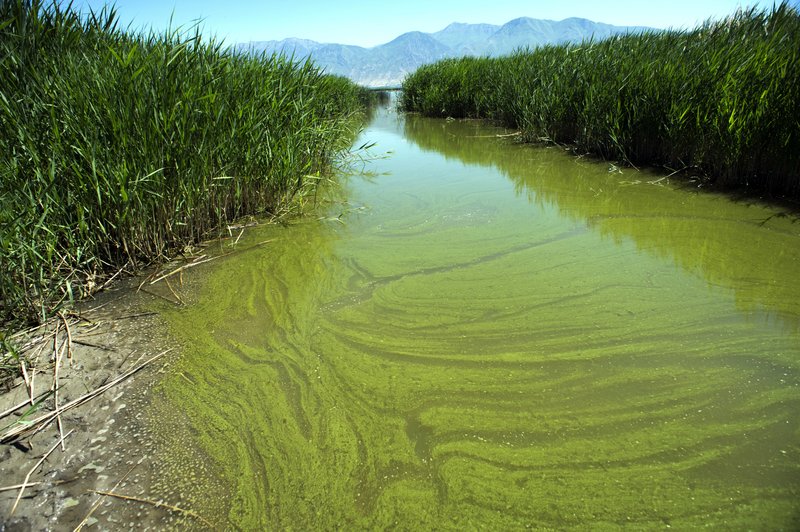
Algal blooms can have negative impacts on other aquatic life like salmon because they grow quickly, covering the surface of a water body and blocking sunlight further down the water column. Other aquatic plants can also grow quickly and block the flow of the stream and access for salmon and other aquatic life. When these plants and algae die, they sink to the bottom and begin to rot. The process of decomposition uses up oxygen in the water, leading to hypoxia or even dead zones. This process of eutrophication can cause big problems for salmon and other aquatic animals!
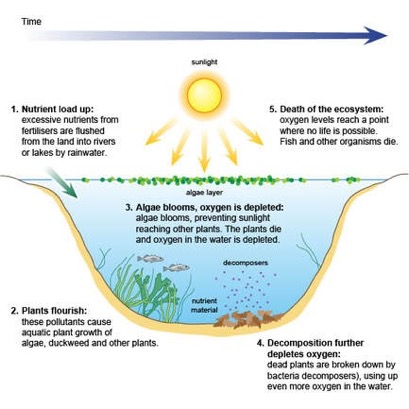
For this reason, it is really important for people to clean up after their dogs and to fix leaks in their septic tanks, otherwise those nitrates could get into our waterways. When kept in balance, nitrates can help our Pacific Northwest forest grow strong and healthy. In fact, salmon returning to spawn in Puget Sound rivers add oceanic nutrients to the forest after they die. The nutrients and nitrates from these salmon will help new plants grow and provide a food source for stream bugs, which baby salmon might eat when they first emerge from their eggs!
There are signs of nitrates all around us, both natural and human-influenced, even in your neighborhood! Bring this Nitrates Bingo activity on your next neighborhood walk and see how many sources you can find!
Procedure
- Print the following bingo card. Each of the squares features a different source of nitrate in our environment. You can also download the pdf here.
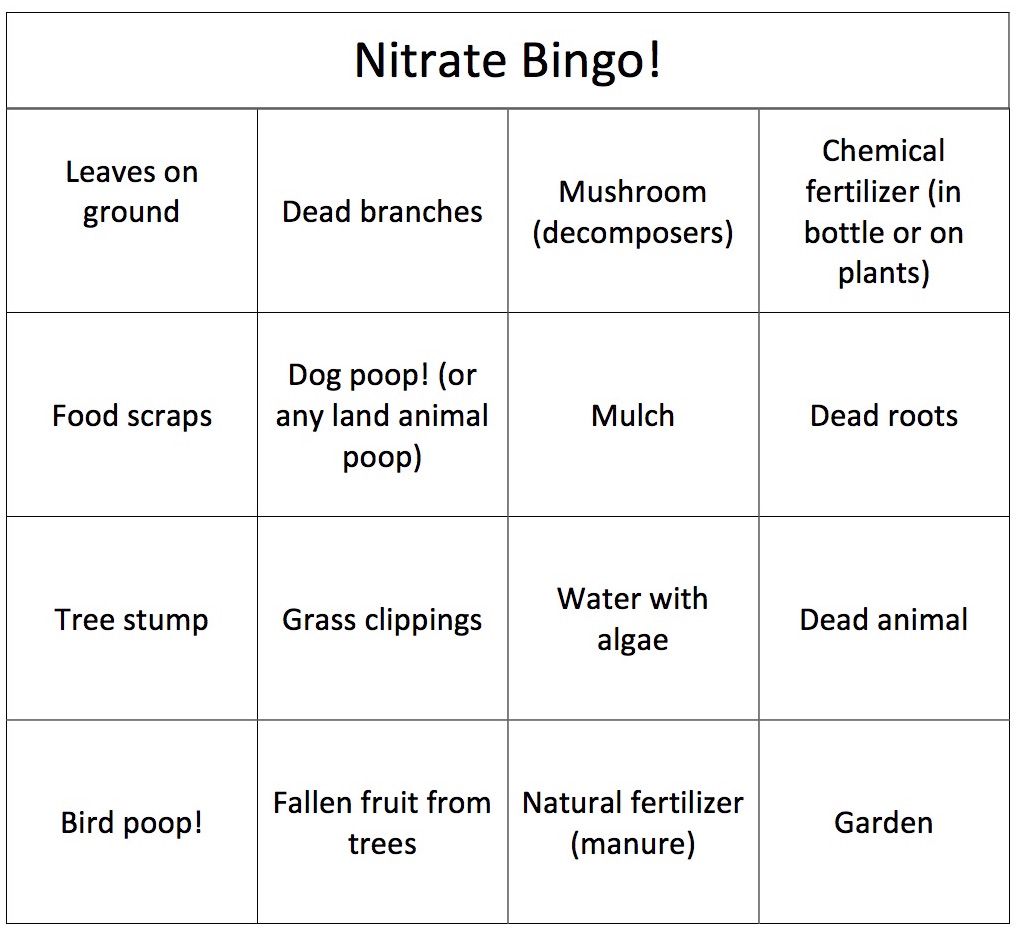
- Plan a hike or walk in your neighborhood or local park. Dress appropriately for the weather!
- Bring your bingo card on your hike. As you walk around, keep an eye out for potential nitrate sources in the environment.
- Check off the nitrate sources boxes as you see them. Go with a family member to see who can get a full row, column, or diagonal first!
- Bonus activity: Write a short evaluation of nitrate sources you observed. Were any of the sources human-derived, or were they all naturally occurring? Do you think this area has high nitrate levels?
Vocabulary
- Algal Bloom: A rapid growth of algae in an area of water caused by an increase in available nutrients.
- Dead Zone: An environment with little to no life as a result of low oxygen levels.
- Decomposition: The breaking down of materials into their base elements.
- Eutrophication: When high levels of nutrients in an aquatic environment lead to algal blooms and subsequent low oxygen conditions.
- Fertilizer: Nutrient-rich material that can provide necessary nutrients to plants.
- Hypoxia: An environmental condition of extremely low oxygen levels that make it difficult for any organisms to survive.
- Nitrate: A form of nitrogen that contains one nitrogen atom and three oxygen atoms. It is a vital nutrient for life.
- Organic: Originating from natural sources, which may be created through decomposition and waste products.
- Primary Producers: Organisms that produce their own food. Most plants, which use photosynthesis to make their own food, are primary producers.
Keep Learning!
- Check out our Water Quality Monitoring page to see how we test for nitrates scientifically and see nitrate data collected by local students!
- Contact Stream Team to install a pet waste pick up station in your neighborhood
- Learn more about Healthy Lawn Care from Thurston County Environmental Health and how you can build healthy soil at home!
- Watch this video from Washington Stormwater Center to see how we are all connected to Puget Sound and get more ideas on how you can help water quality!
- Share pictures of your hike and completed bingo board with us on Instagram! Use the hashtag #GREENfromhome or find us at @southsoundgreen.
South Sound GREEN (Global Rivers Environmental Education Network) is a watershed education program in Thurston County that educates, empowers and connects thousands of local students in watershed studies annually. Through South Sound GREEN, participants engage in science and engineering practices related to water quality in South Sound. For more information, visit southsoundgreen.org.



















































